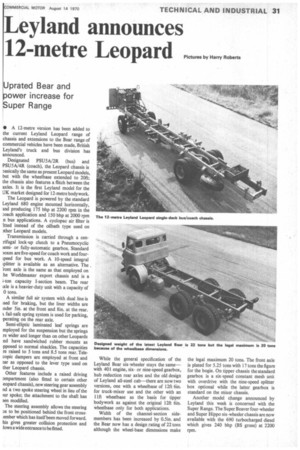Leyland announces
Page 33

If you've noticed an error in this article please click here to report it so we can fix it.
12-metre Leopard Pictures by Harry Roberts Uprated Bear and power increase for Super Range
• A 12-metre version has been added to the current Leyland Leopard range of chassis and extensions to the Bear range of commercial vehicles have been made, British Leyland's truck and bus division has announced.
Designated PSU5A/2R (bus) and PSU5A/4R (coach), the Leopard chassis is )asically the same as present Leopard models, but with the wheelbase extended to 20ft; the chassis also features a flitch between the axles. It is the first Leyland model for the UK market designed for 12-metre bodywork.
The Leopard is powered by the standard Leyland 680 engine mounted horizontally, Ind producing 175 bhp at 2200 rpm in the :oach application and 150 bhp at 2000 rpm n bus applications. A cyclopac air filter is itted instead of the oilbath type used on )ther Leopard models.
Transmission is carried through a cenrifugal lock-up clutch to a Pneumocyclic ;emior fully-automatic gearbox. Standard )oxes are five-speed for coach work and four;peed for bus work. A 10-speed integral ;plitter is available as an alternative. The ront axle is the same as that employed on he Worldmaster export chassis and is a i-ton capacity I-section beam. The rear Ale is a heavier-duty unit with a capacity of 0 tons.
A similar full air system with dual line is secl for braking, but the liner widths are .nder 5in. at the front and 8in. at the rear. k fail-safe spring system is used for parking, .perating on the rear axle.
Semi-elliptic laminated leaf springs are mployed for the suspension but the springs re wider and longer than on other Leopards nd have sandwiched rubber mounts as pposed to normal shackles. The capacities re raised to 5 tons and 8.5 tons rear. Tele zopic dampers are employed at front and !ar as opposed to the lever type used on ther Leopard chassis.
Other features include a raised driving Dmpartment (also fitted to certain other eopard chassis), new steering gear assembly nd a two spoke steering wheel in lieu of the )ur spoke; the attachment to the shaft has aen modified.
The steering assembly allows the steering px to be positioned behind the front crossember which has itself been moved forward. his gives greater collision protection and lows a wide entrance to be fitted. While the general specification of the Leyland Bear six-wheeler stays the same— with 401 engine, sixor nine-speed gearbox, hub reduction rear axles and the old design of Leyland all-steel cab—there are now two versions, one with a wheelbase of 12ft 6in. for truck-mixer use and the other with an 1 lft wheelbase as the basis for tipper bodywork as against the original 12ft 6in. wheelbase only for both applications.
Width of the channel-section sidemembers has been increased by 0.5in. and the Bear now has a design rating of 22 tons although the wheel-base dimensions make the legal maximum 20 tons. The front axle is plated for 5.25 tons with 17 tons the figure for the bogie. On tipper chassis the standard gearbox is a six-speed constant mesh unit with overdrive with the nine-speed splitter box optional while the latter gearbox is standard on the mixer chassis.
Another model change announced by Leyland this week is concerned with the Super Range. The Super Beaver four-wheeler and Super Hippo six-wheeler chassis are now available with the 690 turbocharged diesel which gives 240 bhp (BS gross) at 2200 rpm.




























































































